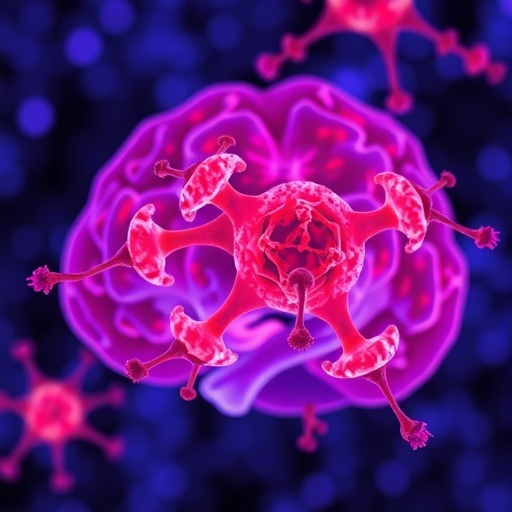In a groundbreaking study published in BMC Neuroscience, researchers have shifted the paradigm in glioma research by meticulously characterising the expression of the P2X7 receptor alongside cancer stem cell markers and immunological mediators within human high-grade gliomas. The study, conducted by a distinguished team led by L.K. Kan, has opened new avenues for understanding the complex interplay of cellular signals that govern the aggressive behaviour of these brain tumours.
High-grade gliomas are notorious for their aggressive nature and poor prognosis, necessitating a deeper exploration of underlying mechanisms that can inform potential treatment strategies. The P2X7 receptor, a member of the purinergic receptor family, has emerged as a pivotal player in cancer biology. Its unique role in mediating cellular responses to extracellular ATP makes it a vital component in understanding tumour microenvironments and immune responses.
The research dives into the intricate relationship between the P2X7 receptor and cancer stem cell markers, which have gained prominence as critical factors in tumour initiation, progression, and resistance to conventional therapies. By incorporating advanced techniques to assess the expression levels of these markers, the team presents compelling evidence of their co-regulation, indicating that alterations in the P2X7 receptor may influence cancer stem cell dynamics.
A notable aspect of their findings revolves around the immune landscape within high-grade gliomas. The researchers meticulously mapped the expression of various immunological mediators, which serve as crucial indicators of the tumour’s ability to evade immune surveillance. Understanding these interactions could lead to innovative therapeutic approaches that enhance immune recognition and targeting of glioma cells.
As the study progresses, it highlights the potential implications for targeted therapies aimed at the P2X7 receptor. Given its role in mediating inflammatory responses and promoting apoptosis in some cancer cells, the development of specific P2X7 antagonists may prove beneficial in the context of high-grade gliomas. The ability to manipulate P2X7 receptor activity could redefine therapeutic strategies aimed at curbing glioma aggressiveness and improving patient outcomes.
The significance of this research extends beyond gliomas, as similar mechanisms may be implicated in other malignancies. The team’s comprehensive analysis paves the way for exploring the role of P2X7 receptors in various tumour types, expanding the scope of potential interventions across cancer research.
Furthermore, the study serves as a call to action for the scientific community to enhance the exploration of purinergic signalling pathways in cancer. With emerging insights into the P2X7 receptor, researchers can elucidate the intricacies of metabolic changes in tumours, paving the way for innovative strategies that target these pathways.
Ultimately, this research not only elucidates the biological significance of the P2X7 receptor within the glioma landscape but also establishes a foundation for future studies aimed at leveraging this knowledge for therapeutic advancements. As the quest for more targeted and effective treatment modalities continues, the insights gained from studying the interplay of the P2X7 receptor and cancer stem cell markers promise to reshape the landscape of oncological therapies.
The implications extend beyond theoretical insights; they offer practical prospects of integrating these findings into clinical applications. There is an expectations that ongoing research will focus on how to manipulate the P2X7 receptor’s pathway to develop combination therapies that could improve the efficacy of existing treatment modalities for glioma patients.
As the research community digests the implications of this work, the focus now shifts to developing clinical trials that will test the feasibility and safety of targeting the P2X7 receptor in patients diagnosed with high-grade gliomas. Such studies could validate the findings from Kan et al. and lay the groundwork for breakthrough treatments that fundamentally alter the trajectory of glioma care.
In conclusion, the comprehensive characterisation of the P2X7 receptor, cancer stem cell markers, and immunological mediators provides critical insights that could significantly influence the future of glioma research and treatment. The cascade of biological events mediated by the P2X7 receptor unveils intricate networks of cellular communication that are ripe for exploration and exploitation in the clinical arena. This promising avenue underscores the importance of continued investment in glioma research, with the potential to catalyse transformative changes in the management of this challenging malignancy.
The weight of this research encourages the community to remain vigilant and engaged with the insights drawn from these findings. Each element of the study contributes to an ever-expanding body of knowledge that seeks to demystify the challenges posed by high-grade gliomas and ultimately contributes to better patient outcomes.
Through the dedication of researchers to unravelling the complexities of these aggressive tumours, we can anticipate a future where precise and targeted treatments not only inhibit tumour growth but also enhance the quality of life for patients navigating the challenges of high-grade gliomas.
As more studies build on this foundational work, the hope for more successful interventions against gliomas in the clinical setting becomes more tangible. The journey from bench to bedside remains fraught with challenges, yet, the collaboration and commitment of the scientific community, evidenced by studies like that of Kan et al., signify a promising step forward in the fight against gliomas.
Subject of Research: The expression of the P2X7 receptor, cancer stem cell markers, and immunological mediators in human high-grade gliomas.
Article Title: Characterisation of the expression of P2X7 receptor, cancer stem cell markers and immunological mediators in human high-grade gliomas.
Article References:
Kan, L.K., Drill, M., Muscat, A. et al. Characterisation of the expression of P2X7 receptor, cancer stem cell markers and immunological mediators in human high-grade gliomas.
BMC Neurosci 26, 59 (2025). https://doi.org/10.1186/s12868-025-00973-5
Image Credits: AI Generated
DOI: 10.1186/s12868-025-00973-5
Keywords: P2X7 receptor, high-grade gliomas, cancer stem cells, immunological mediators, targeted therapies.




